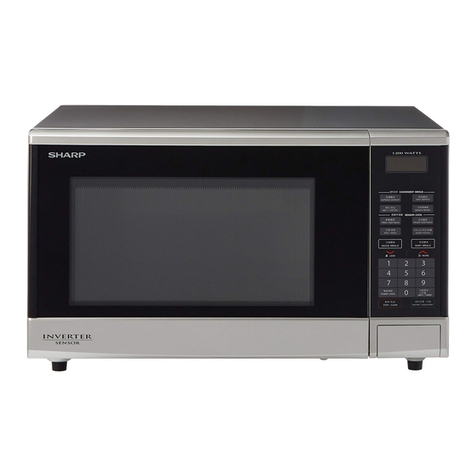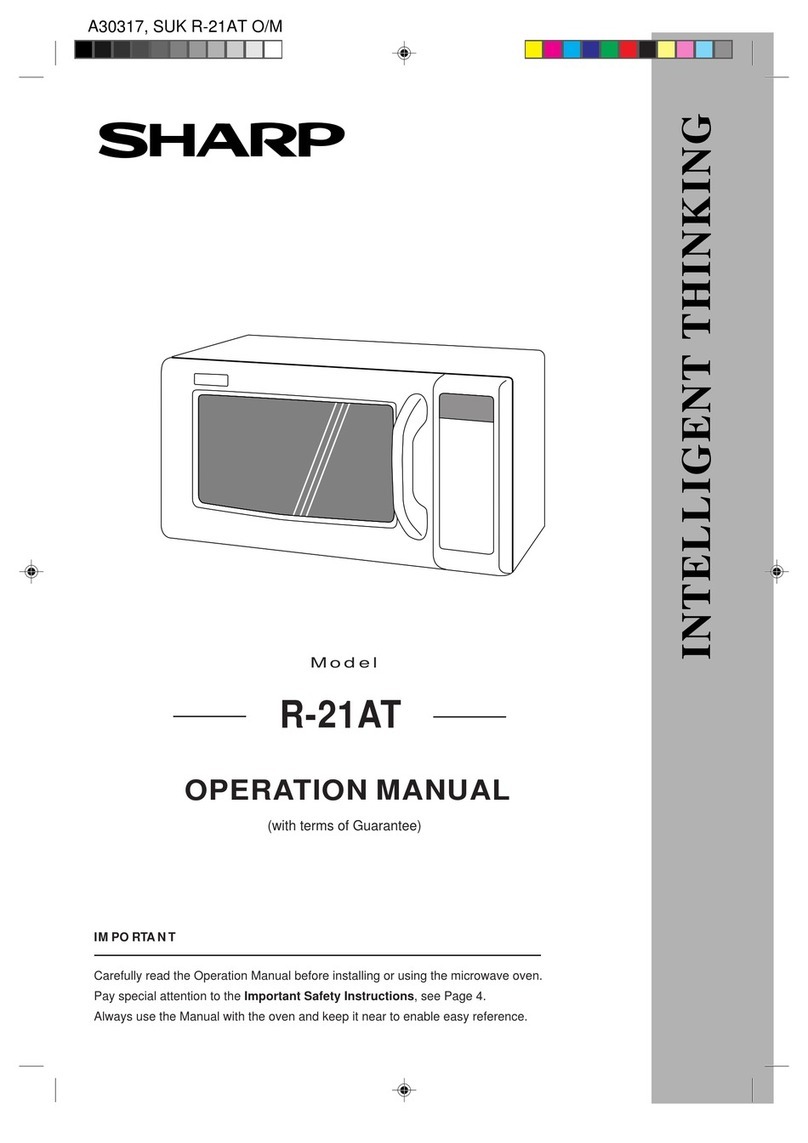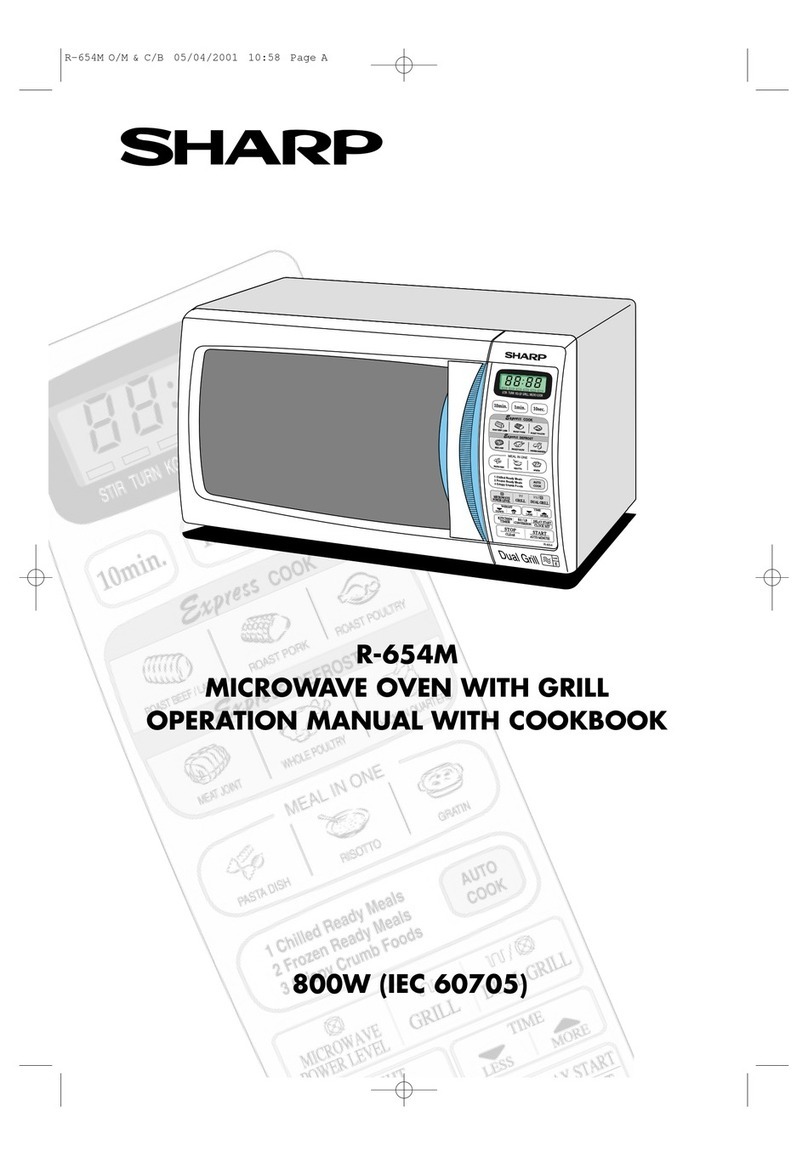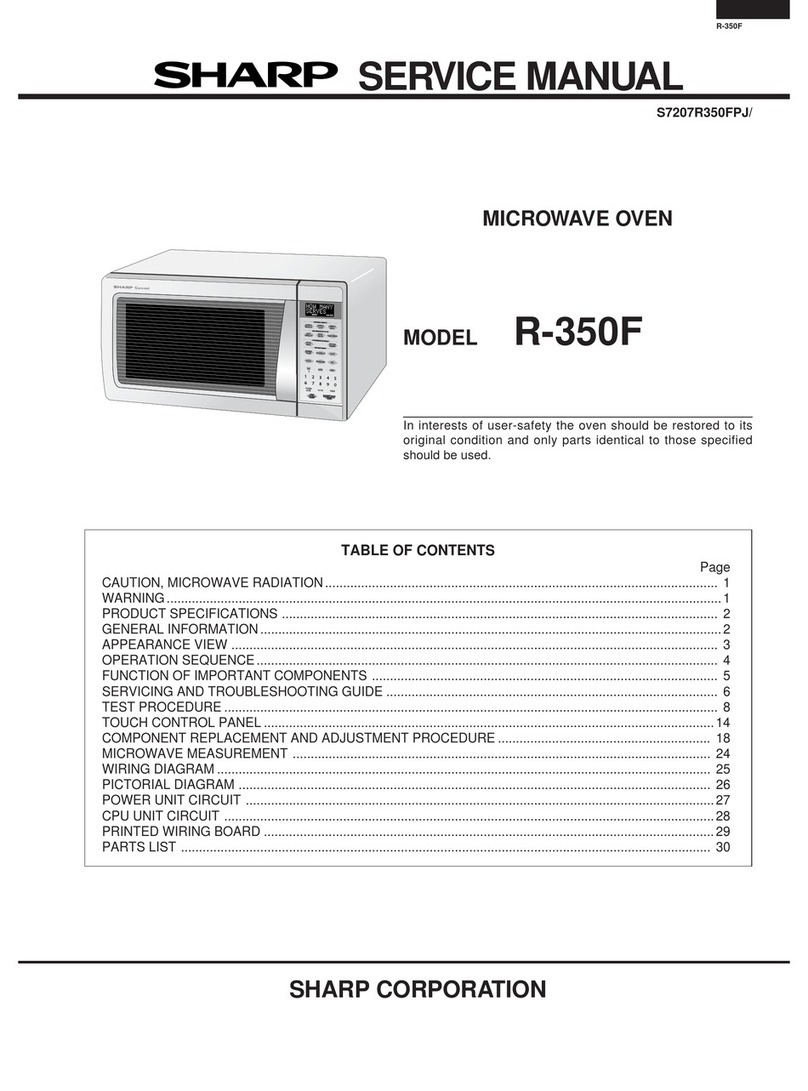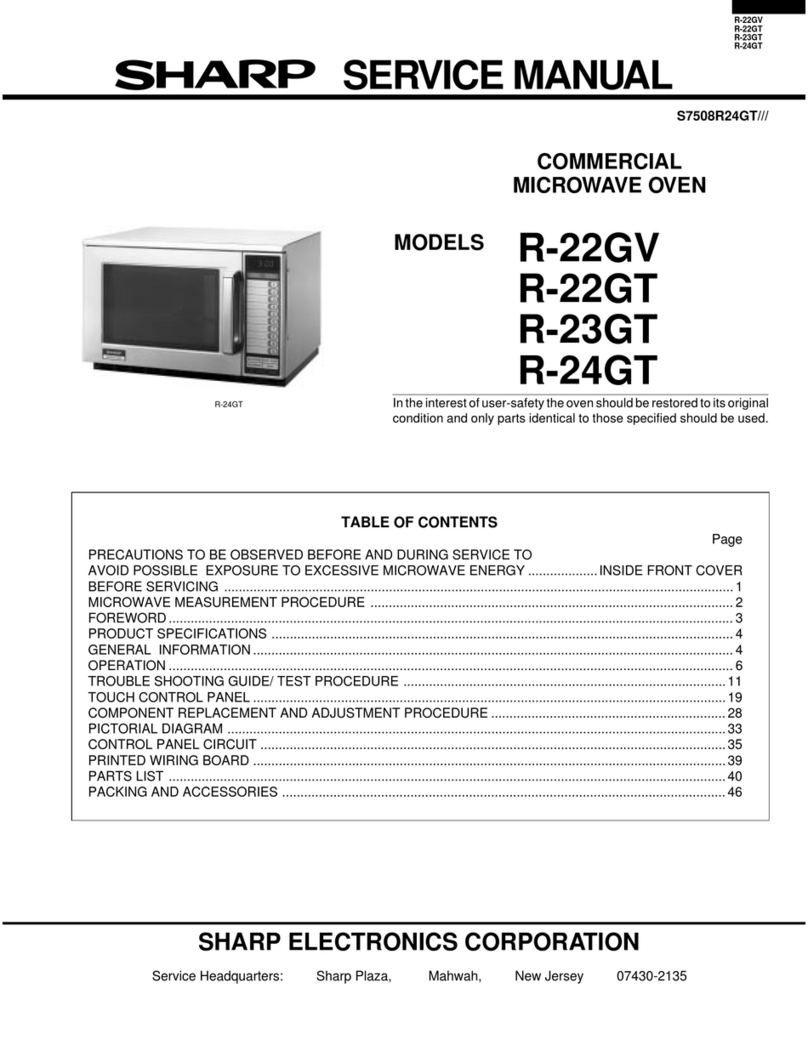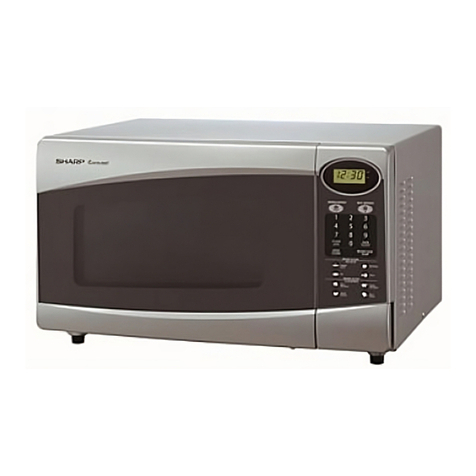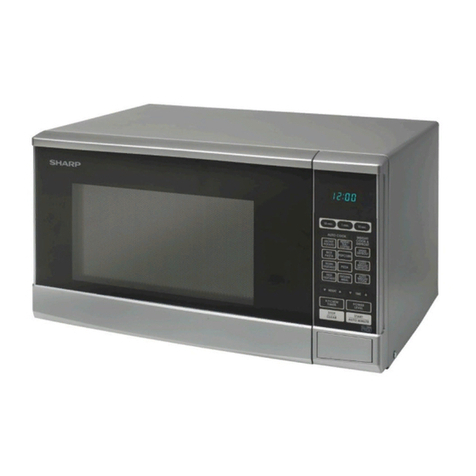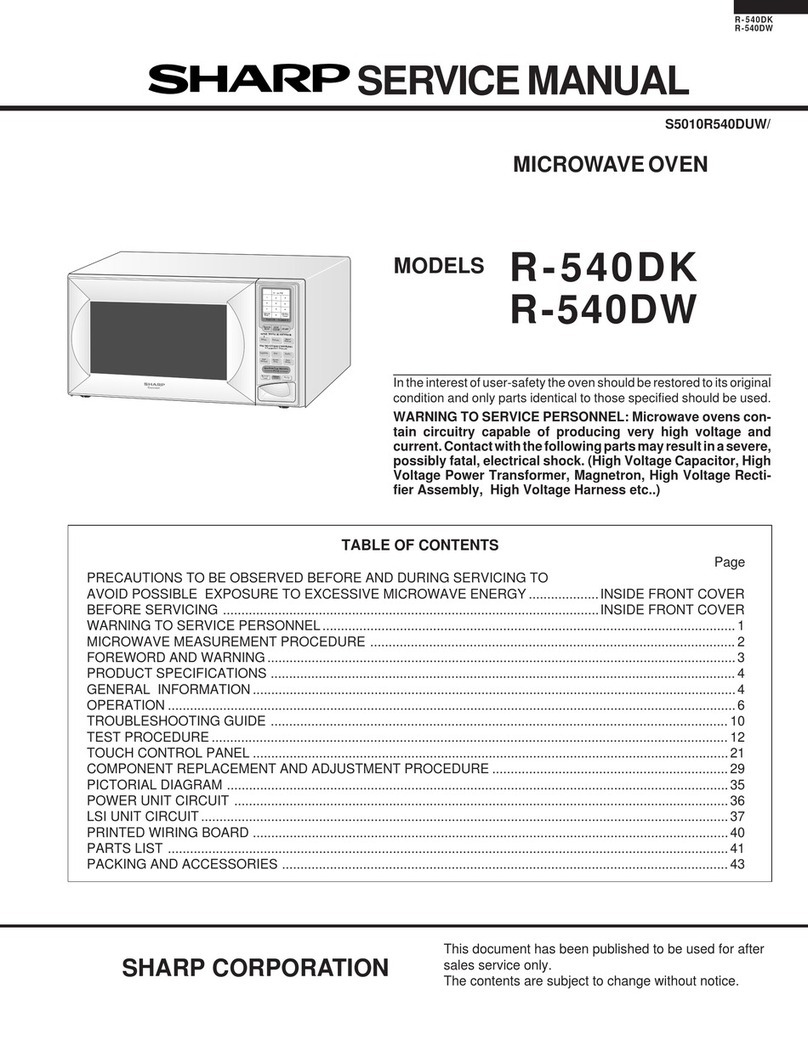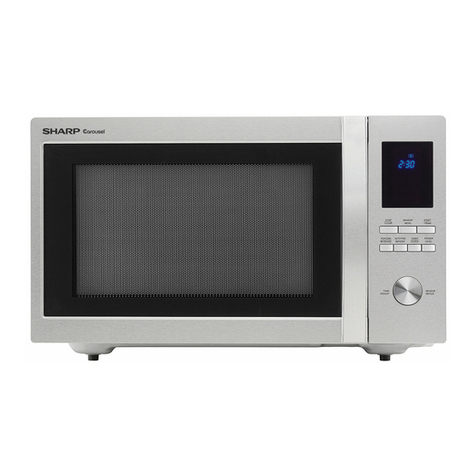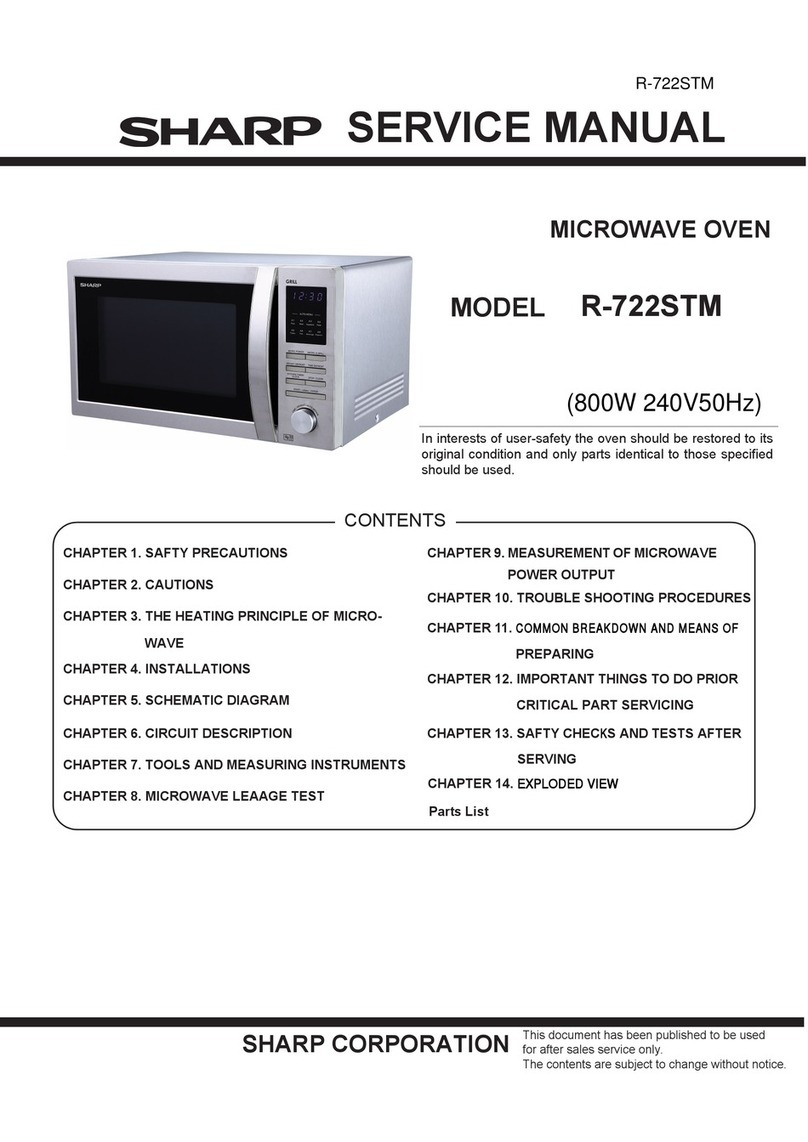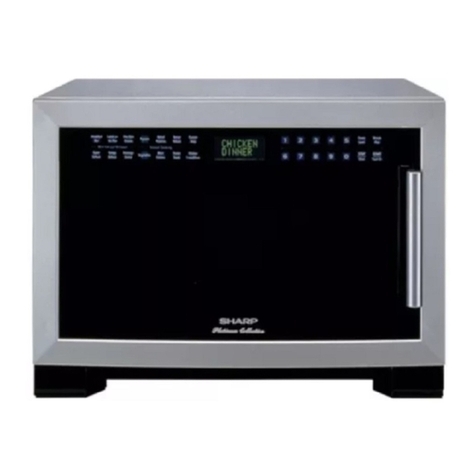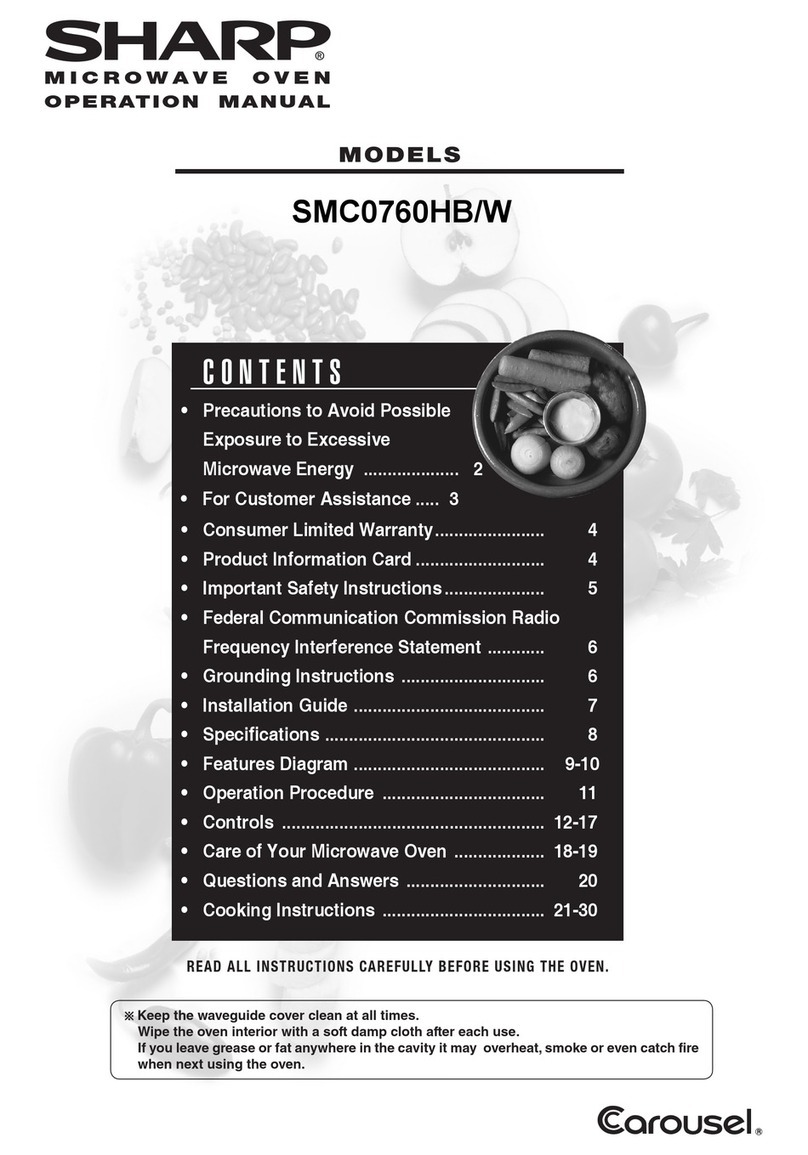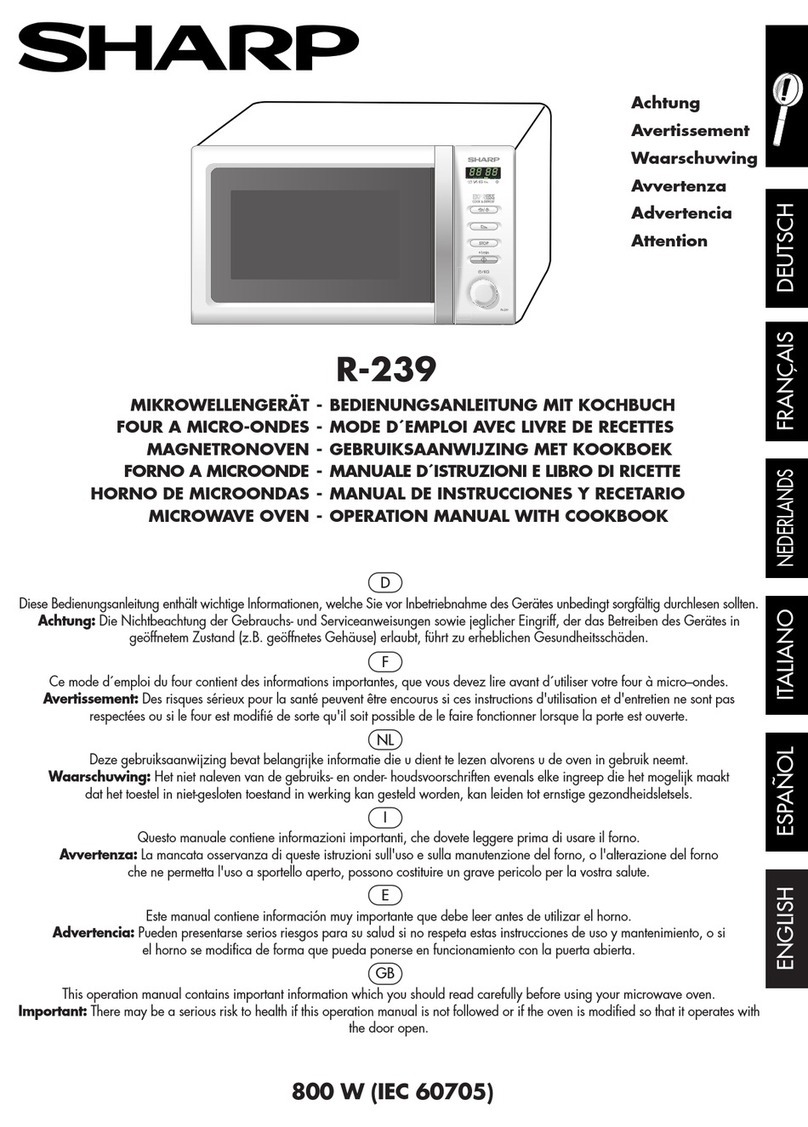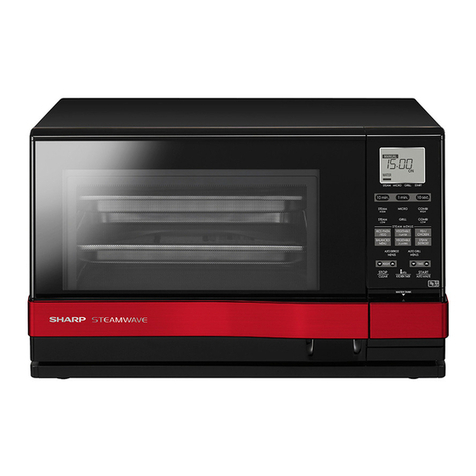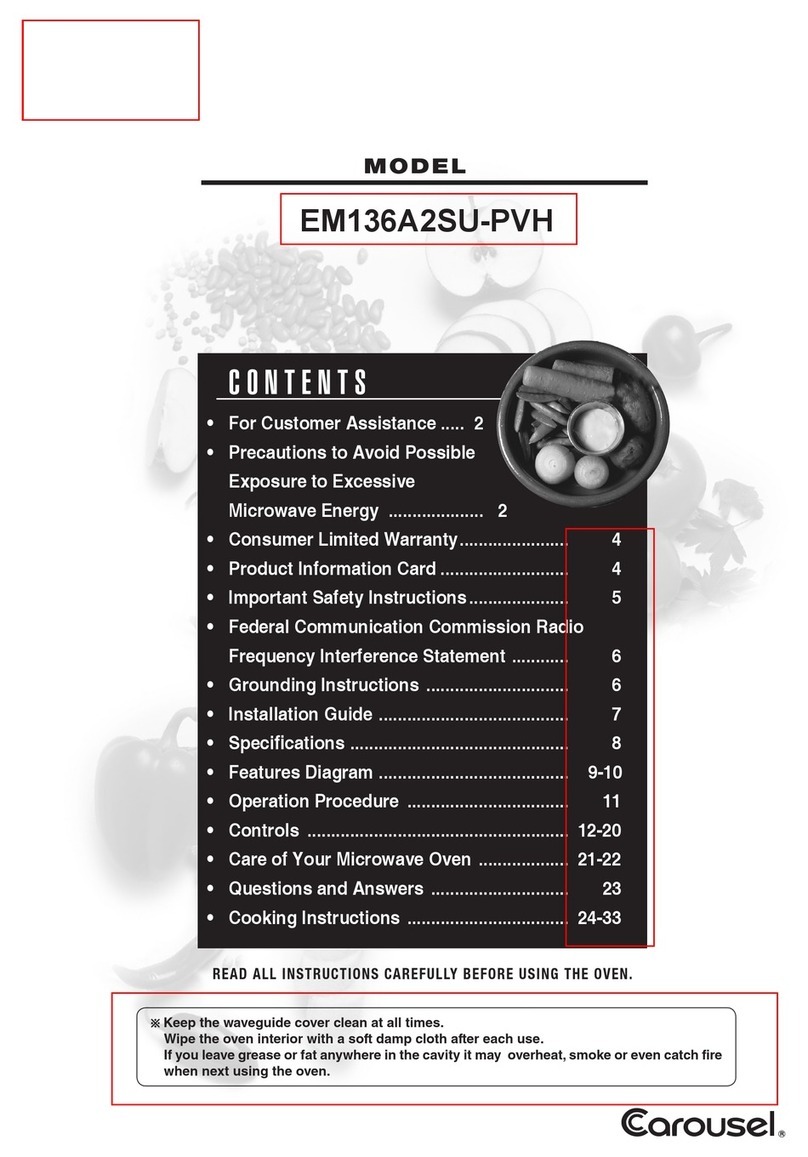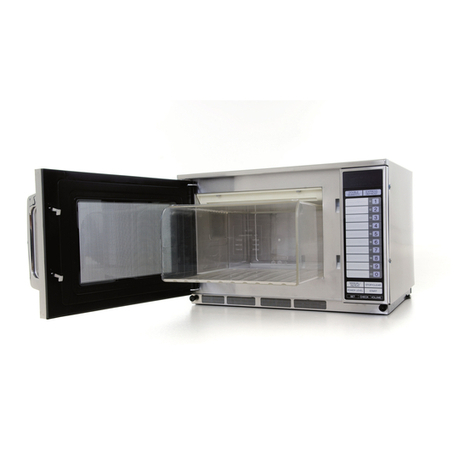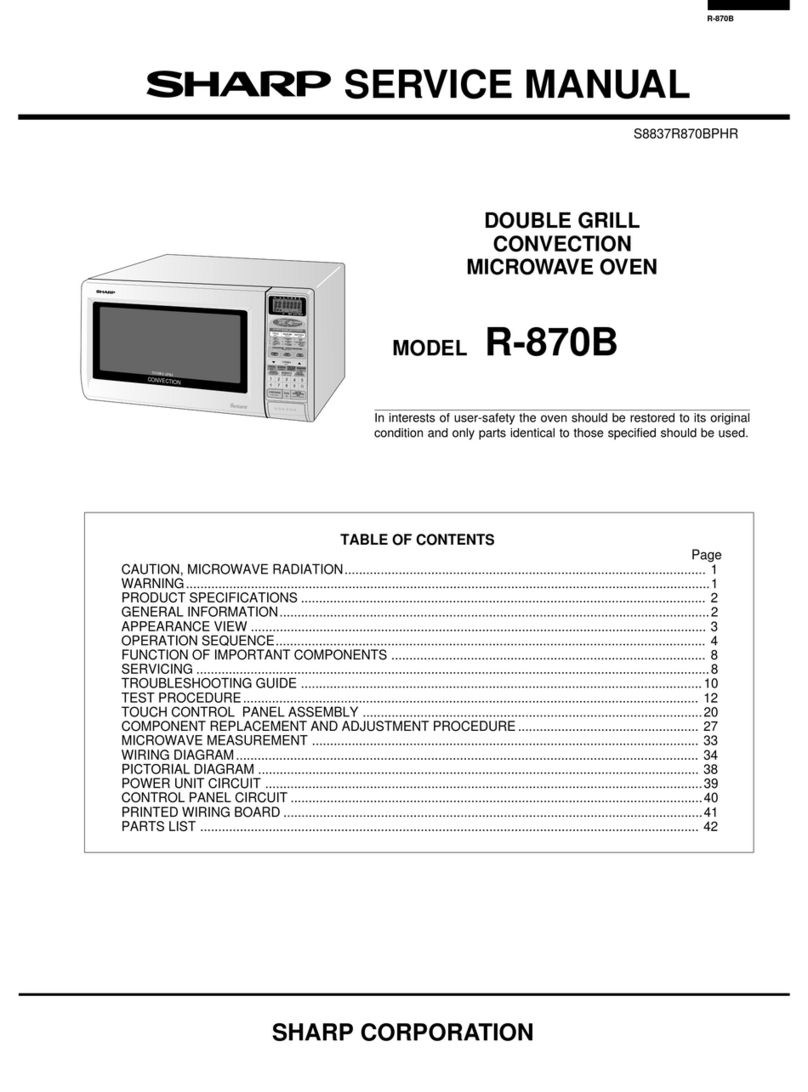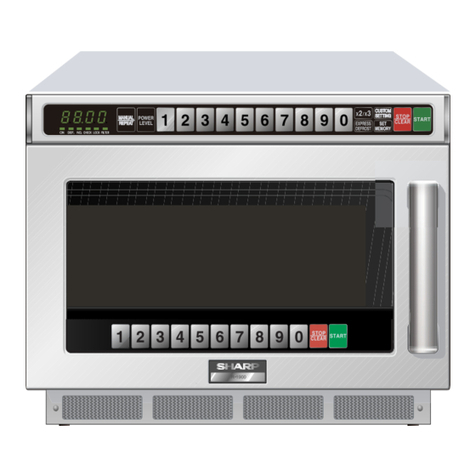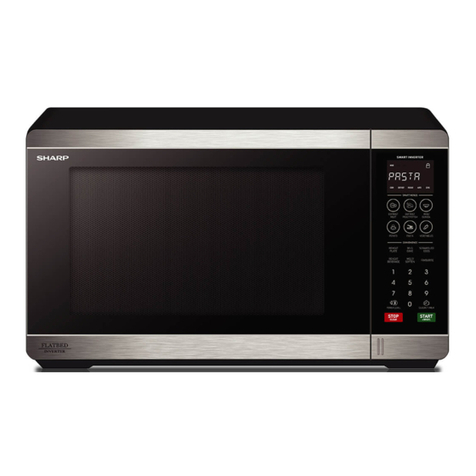
CONTENTS
CHAPTER 1. BEFORE SERVICING
[1] GENERAL IMPORTANT INFORMATION.....1-1
[2] CAUTION MICROWAVE RADIATION ........1-1
[3] WARNING ..................................................1-1
CHAPTER 2. WARNING TO SERVICE PERSONNEL
CHAPTER 3. PRODUCT SPECIFICATIONS
CHAPTER 4. APPEARANCE VIEW
[1] OVEN .........................................................4-1
[2] TOUCH CONTROL PANEL........................4-1
CHAPTER 5. OPERATION SEQUENCE
[1] OFF CONDITION .......................................5-1
[2] MICROWAVE COOKING CONDITION ......5-1
[3] POWER OUTPUT REDUCTION ................5-1
CHAPTER 6. FUNCTION OF IMPORTANT COMPO-
NENTS
[1] DOOR OPEN MECHANISM.......................6-1
[2] 1ST. LATCH SWITCH AND 2ND. INTER-
LOCK RELAY CONTROL SWITCH............6-1
[3] MONITOR SWITCH ...................................6-1
[4] FUSE T6.3A ...............................................6-1
[5] HIGH VOLTAGE FUSE ..............................6-1
[6] TEMPERATURE FUSE 150C (OVEN).......6-1
[7] TURNTABLE MOTOR ................................6-1
[8] FAN MOTOR ..............................................6-1
[9] NOISE FILTER ...........................................6-1
CHAPTER 7. TROUBLESHOOTING GUIDE
[1] FOREWORD ..............................................7-1
[2] CHART .......................................................7-1
CHAPTER 8. TEST PROCEDURES
[1] Procedure A : MAGNETRON (MG) TEST.....8-1
[2] Procedure B: POWER TRANSFORMER
TEST ..........................................................8-2
[3] Procedure C: HIGH VOLTAGE RECTIFI-
ER TEST ....................................................8-2
[4] Procedure D: HIGH VOLTAGE CAPACI-
TOR TEST..................................................8-2
[5] Procedure E: SWITCH TEST .....................8-3
[6] Procedure F: TEMPERATURE FUSE
TEST ..........................................................8-3
[7] Procedure G: MOTOR WINDING TEST.....8-3
[8] Procedure H: FUSE T6.3A .........................8-3
[9] Procedure I: NOISE FILTER TEST.............8-3
[10] Procedure J: HIGH VOLTAGE FUSE
TEST ..........................................................8-4
[11] Procedure K: TOUCH CONTROL PANEL
ASSEMBLY TEST ......................................8-4
[12] Procedure L: KEY UNIT (MEMBRANE
SWITCH) TEST ..........................................8-4
[13] Procedure M: RELAY TEST........................ 8-5
[14] Procedure N: PROCEDURES TO BE TAK-
EN WHEN THE FOIL PATTERN ON THE
PRINTED WIRING BOARD (PWB) IS
OPEN.......................................................... 8-5
CHAPTER 9. TOUCH CONTROL PANEL ASSEM-
BLY
[1] OUTLINE OF TOUCH CONTROL PANEL..... 9-1
[2] DESCRIPTION OF LSI ............................... 9-1
[3] SERVICING FOR TOUCH CONTROL
PANEL ........................................................ 9-3
[4] PRECAUTIONS FOR USING LEAD-
FREE SOLDER .......................................... 9-4
CHAPTER 10. COMPONENT REPLACEMENT AND
ADJUSTMENT PROCEDURE
[1] BEFORE OPERATING ............................. 10-1
[2] OUTER CASE REMOVAL ........................ 10-1
[3] POWER TRANSFORMER REMOVAL ..... 10-2
[4] HIGH VOLTAGE RECTIFIER ASSEMBLY,
HIGH VOLTAGE FUSE AND HIGH VOLT-
AGE CAPACITOR REMOVAL .................. 10-2
[5] MAGNETRON REMOVAL ........................ 10-2
[6] POSITIVE LOCK CONNECTOR (NO-
CASE TYPE) REMOVAL .......................... 10-2
[7] TURNTABLE MOTOR REMOVAL ............ 10-3
[8] COOLING FAN MOTOR REMOVAL......... 10-3
[9] POWER SUPPLY CORD REPLACE-
MENT........................................................ 10-4
[10] CONTROL PANEL ASSEMBLY REMOV-
AL ............................................................. 10-4
[11] GRAPHIC SHEET AND MEMBRANE
SWITCH REPLACEMENT........................ 10-4
[12] 1ST. LATCH SWITCH, 2ND. INTERLOCK
RELAY CONTROL SWITCH AND MONI-
TOR SWITCH ADJUSTMENT .................. 10-5
[13] 1ST. LATCH SWITCH, 2ND. INTERLOCK
RELAY CONTROL SWITCH AND MONI-
TOR SWITCH ADJUSTMENT .................. 10-5
[14] DOOR REPLACEMENT ........................... 10-6
CHAPTER 11. MICROWAVE MEASUREMENT
CHAPTER 12. CIRCUIT DIAGRAMS
[1] Oven Schematic ....................................... 12-1
[2] Pictorial Diagram (Figure S-1) .................. 12-2
[3] Control Unit Circuit (Figure S-2) ............... 12-3
[4] Printed Wiring Board (Figure S-3) ............ 12-4
Parts List
